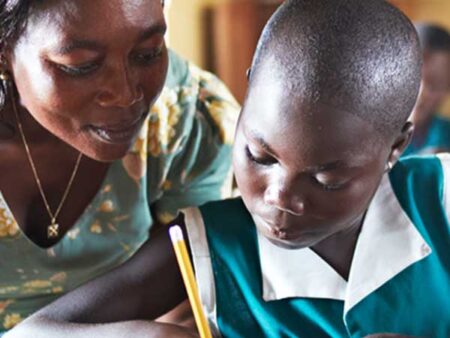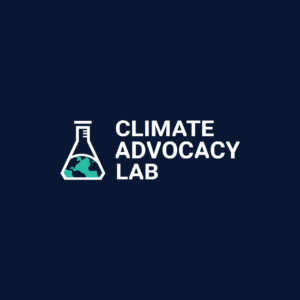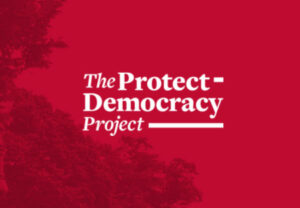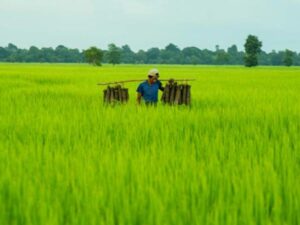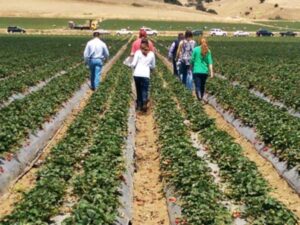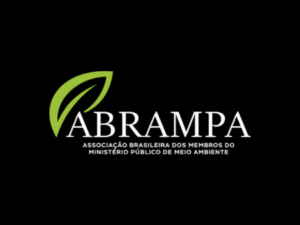CAMFED supports the educational advancement of girls and young women in Tanzania, Ghana, Malawi, Zambia and Zimbabwe through financial and social support.
Lydia Wilbard of CAMFED spoke with Catherine Edwardson March 27, 2023. Click here to read the full conversation with insights highlighted.
Catherine Edwards: The first question that I have is about the problem that your work addresses. How would you describe the problem and how are you addressing it?
Lydia Wilbard: I joined CAMFED 15 years ago when I helped the established organization [start] in Tanzania. I actually founded the network for young women in Tanzania back in 2005. CAMFED has been supporting girls in some marginalized communities in five countries to date. That’s Tanzania, Ghana, Malawi, Zambia and Zimbabwe. We support them to go to school, learn and thrive when they get there, but also we want them to become independent and influential leaders.
The girls that we work with face many barriers to education compared to boys, especially at the level of secondary school. They are more likely to be pushed out of school due to many factors grounded in poverty and gender inequality.
Our programs provide both financial and social support, and ownership of the program is within the communities we serve. The communities are responsible for identifying those who are in need and create a network of wraparound support. This includes providing mentorship, making sure that they have food when they go to school and when they go back home, and building the infrastructure they need to have for them to learn. They also alert the authorities if there are any cases of abuse or child marriages. It’s a whole set of sustainable holistic supports.
I would say we come in to support them on the things they are already trying to do. We provide them with support so that they can do more and in a structured way to protect and support girls to go to school. For example, a large proportion of our leadership within the organization, from the grassroots up to the international level, is made up of women who, like me, have a deep, intimate understanding of what it looks like to be excluded from school. So we work from firsthand experience and we are committed to stopping at nothing to make sure other girls like us are able to access opportunities to go to school. That every child then secures the right to an education and they’re able to thrive.
That is what CAMFED does and how we come in as the driver for the cause.
Catherine Edwards: Can you talk a bit more about how you identify the communities or the individuals that you help, how you make that contact with them?
Lydia Wilbard: I am from Tanzania, so I talk as a local. Someone will talk to me and I’ll make sure that I make the connection to the government. Most of our governments in the communities we work with are very structured. We have villages, we have wards, we have schools, we have regions, and we also have the national level. Within the national level we have appropriate ministries, and the ministries already have the priority of supporting children through school for example. We have a ministry that is responsible for social welfare that girls from marginalized communities will fall into. So we build partnerships straight away. And these partnerships are formally written down, through for example a memorandum of understanding, which provides an opportunity to discuss and identify specific roles through which the organization can complement the priority of the government.
We now work with these ministries to make sure that we are introduced to the communities up to the grassroots level. The grassroots level, this will be a structure that is very close to the families. In some communities there will be structures that already exist to identify and document the number of children who come from marginalized communities. In some of the countries, there may be similar structures or we will remodel structures to set up. And then we will empower them with the skills and the tools and the resources so that they will be able to go ahead and identify people with the criteria.
In Tanzania for example, the ministry has a list of criteria for marginality. They will say, for example, orphan, double orphan, maybe someone living with people who are over 60 years old or maybe child headed families. We are able to work with the communities to validate and make them aware of these criteria, and then they help to identify these children. Once they have been identified, they will be vetted and ranked by the community through formal structures. And then for us, we will receive a list of those who are in need and what their specific needs are, and send those to the district education officer who is now responsible for the education at that level. From there we pick it up and start working with the school for support.
Catherine Edwards: What makes your approach distinctive? What do you do that no one else is doing or no one else was doing when you started?
Lydia Wilbard: I don’t want to brag about being distinctive, we all complement each other. But I think many times our approach has been endorsed by the deep-rooted community owned and engagement. Some approaches do not leverage the local expertise and knowledge enough, and the power that lies within these communities.
For us, for example, we work with young women who are part of the program. They’re not just the beneficiaries, but they’re core implementers and shapers of what needs to be done to support the next generation of children through school. These young women are key, but they also work with local traditional leaders, village leaders. That level of engagement isn’t something that is common. It’s really deep, consistent, and sustainable. To a point that they are able to make decisions that we cannot counter fact.
For example, they are also the drivers of getting the items that they need to procure and figuring out what they need to do. We have young women who are implementing the support mentorship program within the school. We supported them with the training and the tools and the connection, wraparound support, and then they started implementing these life skills within the school to be able to support the next generation of children who are still in school.
So I think our focus on local ownership and expertise has been unique and key in driving everything that we do.
Catherine Edwards: What do you think allowed you to get to that point? Was there a specific process that you followed to set up this kind of deep and sustainable engagement with the communities?
Lydia Wilbard: I think the organization has very well documented values and principles and one of the key principles is collaboration. And also urgency and a respect for the local knowledge. We know that we don’t know everything, and I think that’s a key thing.
It’s been 30 years now since our establishment, so over time we have learned that the communities know their challenges better than we can pretend to and that they know what works and what doesn’t work. Over the years we have been able to demonstrate this through the alumni network that we have set up, which is now a quarter million, 250,000 people, across five countries. They are the true examples of the impact of what works. And so over time we have learned that if we put appropriate timely resources and the skills into their hands, they’re able to do things more than we anticipate or we expect.
I think this is what we have been able to shape over time. When we started back in 1993 in Zimbabwe with 32 girls being supported to go to school. It wasn’t the same as when we started in Tanzania. In Tanzania, it was 2005, and we started that with the network of young women, supporting them to do what they’re already doing. To do it better by providing appropriate resources and wrap around support in terms of connection to the leadership of the community and grow them to become leaders in their communities. Then we saw that we can actually speed up the impact that we want to see.
While in Zimbabwe we started with supporting girls through school, in Tanzania, we picked it up by setting up the network of young women who were then able to be part of the identification of the children to go to school.
Catherine Edwards: Do you have a few more examples of the impact that your work has had in the different locations?
Lydia Wilbard: We have had some evaluations, but I know this talk is not about deep evaluations and the statistics. One of the exciting things for me at this point is that I have just recently stepped into a new role as Executive Director of Learning and Engagement, after being a National Director for 10 years. Through this I am representing the organization on the global stage and also presenting the research of what works. This gives us an opportunity to meet with people and share our experience, but also work closely with the communities and government ministries to scale what works.
To give you an example of what we have been able to achieve so far, which is also what my role is about, we already sent 5.5 million children to school across five countries. This is fundamental for transforming the system. More girls completing school means more female representations at leadership levels in all spheres. If we want to have female representation at the decision-making table, it needs to begin with sending more children to school. So that is why I’m talking about the 5.5 million critical mass of children from marginalized communities going to school.
We have evidence that shows that the girls that are supported by CAMFED, are able to complete school. For example, they are three times less likely to drop out of school. They have grown their confidence and, in a survey, we were able to hear from 95% of the girls saying that they’re better able to shape their life goals. When they think that they are in control, then it’s a different trajectory.
We also have other examples of the multiplier effect where we take one girl and then she’s able to support on average three to five children to go to school. And that really is multiplication. If you want to educate more children, then you will start with girls’ education.
I can share a few more examples of the leadership potential that we have seen and how things have changed through sending girls to school. For example, Stumai is from Morogoro district in Tanzania. She’s a former student supported by CAMFED and she was trained to be a mentor. She has been able to change the perspective of girls’ education in her local community, especially the main village heads, which are kind of traditional. She engaged with the village heads to successfully bring a school [inaudible] to one of the secondary schools that she came from in the ward.
She also became a successful businesswoman, supporting other children through school and creating jobs through a motorcycle tax business. So she’s employing people who are doing business for her. She was able to build a house for her disabled mom and now she’s working with the company to advocate scaling our Learner Guide Program so that we can bring up more leadership like this in our local communities. She’s advocating for the Learner Guide Program to be rolled out throughout all the national secondary schools in Tanzania.
Asha is another example who was supported through school by CAMFED and she completed it in 2012. She joined CAMFED Association which is an alumni network, and now she’s been elected Vice Chairperson of the District Health Committee in Kibiti district in Tanzania. This is a big, district-level committee where she brings a gender balance to their approach to local and regional decision making. She ensures that healthcare issues that affect women and girls remain at the fore.
This is just from Tanzania, but I know other young women who are doing wonderful work in Zimbabwe, Zambia and Malawi. One I recall is Fatima, who was able to talk to the local chief to change the ways things work for women in her community. She’s a teacher and she went to the chief and told him she wasn’t happy with how things were working out for women in the community.
This chief said, “Who are you? What are you speaking? Are you not just a girl?” She said, “Yeah, I am a girl, Chief, but I am now a teacher. That’s why I am able to come and talk to you. But if you could know the scars that are in me that are not visible, you would not believe it. Some of these scars will remain, they are internal. You can’t see them unless I talk about it. The chief was really able to listen and she narrated how things are not working and how things should work. The chief concluded by saying, “Next time we talk about how to support this community and the women, please make sure that Fatima is on the committee because she’s now our teacher.” So this is the impact that spills from the individual and goes to the system as a whole.
Catherine Edwards: How do you measure the success of your work, how well it’s working, and keep track of these impacts?
Lydia Wilbard: We have a framework of learning and measurement and evaluation to track our work. We’ve set up a database so we can be very comprehensive and track each and every girl that we support by tracking the statistics from the beginning. We track the milestones, so if we pay school fees, if we provide social support, we will be able to get it in.
And then we work with the schools and community leaders, we support them with phones, which are built with the tools that can send us information. We have data that comes alive in our database. We are able to enter information, like their attendance, their performance, if there is anything that is changing, maybe they now want to go from one class to another, what they need us to pay for. This lets our local people, our stakeholders, be equipped with the skills and technology and the tools to be able to bring in the data that we need to be able to respond on time. Through this database, we are able to do different analyses to learn about emerging issues and through which we inform the designs of our programs.
Beyond that routine monitoring, we also have portal surveys, for example, in the business for the young women that we support. We also have annual surveys, which sometimes include other countries, so that we can be able to have comparisons between districts or between countries.
We also embark on larger research projects. Sometimes we build in our funding to be able to do baseline, midline, and endline research through which we are specifically looking at the impact that is evolving over years. Some of the findings that I shared in terms of dropout rate, we are able to compare our implementation programs with other districts where we are not working. We are able to show the difference and we are able to see what is added by our program.
Catherine Edwards: Sometimes learning from mistakes can be some of the most instructive parts of social innovation. Was there anything along the way that you tried that maybe didn’t work or didn’t work in the way you expected, and what did that teach you?
Lydia Wilbard: One thing we should mention is the challenge or the agility that we have to adapt because we are working through the government systems. We work with the schools that are government schools, we work with the teachers, we work with the government officials, so sometimes we have had to adapt according to how the government system works.
For example, five years ago we learned that the government in Tanzania had changed their system of payment for money that goes to government institutions. All of these years we were sending funds to schools’ accounts for them to be able to do procurement of the entitlement for the children on time. But we learned that because of the change, the schools would no longer be able to receive the funds without going through a budgeting process through which they can indicate that we anticipate using this money and will provide a specific code, and therefore they can withdraw the funds when we send it to them.
Agility and the adaptations that we have had to make, sometimes uncomfortably or sometimes under pressure, were needed because the government system works differently from when you are your own system. We have had to link the government system and ours to be able to be proactive with how things work.
Sometimes the government doesn’t accept things quickly. One approach that we have learned is that you need to align with the priorities of the country and the government so that you can be able to push things. So proactively understanding the education sector development plan, understanding the five-year development plan, so that you can align to it. And these things can change at any time.
So I think agility is important for us, and making sure that the government really understands what we are doing, not just endorsing it, but really getting into it. Sometimes because we work with government officials, we have to build it in the budget to be able to retrain because there is no direct control of who will be in school this year or might move to another school where we are not working. We have had to be adaptive in terms of even proactively budgeting for the retraining and reorientation that is necessary for the program to continue.
Catherine Edwards: We know that funding is a big challenge for anyone doing social change work, but aside from funding, what are the main challenges that you’ve come across in the work?
Lydia Wilbard: I think one thing I should also note is that the context is not static. Policies and guidelines that govern our workers, the CSOs, and also sometimes the policies and guidelines that provide a platform for us to work, can be barriers. For example, not long ago we did not have a re-entry policy in Tanzania. So if girls drop out of school, you can support them financially – and just to mention that we don’t only support them financially but we also support them socially – but if the policy does not allow children to come back when they have dropped out, then your work is almost not able to go on. So the policies and guidelines that govern the country sometimes have been a barrier. Apart from designing your implementation, you also need to make sure that you have platforms through which you can advance the advocacy for policies and guidelines, not only for enactment but also for implementation.
Sometimes there is a policy but you do not see it operationalizing, or sometimes the misinterpretation by the local leaders actually makes the policy not being implemented. I gave an example of the reentry policy. While in other countries we had a reentry policy by the government, we did not have a reentry policy until recently. For us reentry policies are critical, especially the fact that we support marginalized children, marginalized girls. Sometimes they dropout not because they wanted to, but maybe they are forced into early marriage or they are raped and get pregnant, or sometimes they just went missing and by the time you recover them they are already out of the period that the government will accept them.
We were able to join the coalition members of education in Tanzania through which we were successful to get that guideline signed by the ministry. Now we are still working to make sure that it’s a law because otherwise anything can change at any time. So that is one challenge that I would highlight in terms of the working environment and the policies that might impair what we are trying to advance.
Catherine Edwards: You mention advocacy to change some of the laws and policies. Could you explain a bit more how you are working on advancing the system level change?
Lydia Wilbard: One way, as I mentioned with my new role, it’s a deliberate opportunity to be able to systematically document what works and the experiences we have gathered over time, so that we can bring evidence to the government to demonstrate what works, so that we can support more children to go to school.
We also joined an education coalition. In both of our countries, we have local education groups that are made up of civil society organizations who are working in education and systematically meet in a forum. So there’s an umbrella through which we join and then have a deliberate advocacy agenda.
We go as a team, we bring in our experience, others bring their experiences, and we are able to come up with a paper. Through that, we are represented within every government decision making body. We join the education sector development committee through which we pass policies, we review evidence, and join the education sector joint education monitoring. We deliberately take them to where they can see things and then we can come to the table and say, “Unless we do this, this is not going to change.”
Through this forum, we expose them with evidence that we have gathered over time, and we do it as a joined voice. We join other teams so that we can advance our voice and the voice can be bigger. For example, in Tanzania we are leading the Girls’ Education Caucus through the Tanzania network. As a lead institution we are able to bring other stakeholders to help draft our position paper to the government, to share the experiences with the re-entry policy, what is not working, what is on the grassroots that is delaying the speed, and what we suggest the government can do to be able to leverage the policy.
Catherine Edwards: What do you think, if anything, is needed from other actors or other groups in order for progress in the system level change?
Lydia Wilbard: I think one thing that we needed to learn is building on what has worked, not necessarily everyone to go in and to test something new. If we can learn what is already working, what is supported by evidence, then we can build it on.
There is a willingness even for funding collaboration, so that there is enough money to leverage the system transformation. I think other actors in the field would be able to join efforts on the models that have worked to be able to scale them. Some other organization can start scaling an already working model rather than trying to start a model, so that we don’t always repeat something that might have already worked.
Catherine Edwards: My last question is quite a broad one. How do you see your work evolving over the next five years?
Lydia Wilbard: Our flagship program, which is key for our organization, is the Learner Guide Program through which our young women graduates go back to their schools and support teachers to be able to deliver the life skills program, which also embeds wellbeing, organizing study groups, and helping pushup learning for young children, both boys and girls.
This program is very important because it keeps girls in school and out of child marriage, but it also help boys start learning about how to interact with girls, that they should support each other instead of competing, and in that way we are changing the trajectory of the next generation. And because it is done by the young women themselves, they are able to eventually attract buy-in from their communities and they are able to show what is possible when girls learn and lead.
At CAMFED, we are excited to be working with the Ministry of Education in all countries where we operate, to be able to begin the scaling journey of this Learner Guide Program. Our aim is to see all the schools in our working countries and beyond have the Learner Guide Program and that each child and – boys and girls – are able to have a role model. There are also young women within the community who are first responders and they’re able to connect with children and their families and they’re able to solve many challenges.
Over the years, CAMFED has been able to work with communities to get more girls to go to school and to become leaders. One of the things we want to see in the next five years is having the girls play a critical role within education and improvement of the education outcome for both boys and girls through the government education system.
Catherine Edwards: Is there anything that we didn’t get a chance to cover that you think is important to mention before we wrap up?
Lydia Wilbard: I would just reiterate the importance of the grassroots village, locally owned initiatives, and leveraging the expertise and energy of the young people, especially young women. And the importance of having them at the decision making table. If that could be a goal for everyone, then we will have changed this world to become better.
Catherine Edwards: Thank you so much, it has been super insightful to hear about your work.
Click here to read the full conversation with insights highlighted.
Catherine Edwards is a journalist and content strategist based in the UK, having also lived and worked in Germany, Italy, Sweden and Austria. She supports newsrooms and mission-driven organisations with content strategy, audience development and constructive journalism.
* This interview has been edited and condensed.
Find more organizations supporting education for girls.

